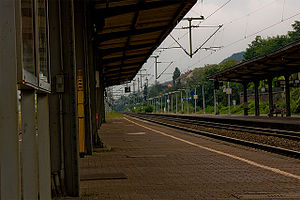Bingen Stadt station
| Through station | |
 |
|
| Location | Espenschiedstr. 1, Bingen am Rhein, Rhineland-Palatinate Germany |
| Coordinates | 49°58′11″N 7°54′19″E / 49.969793°N 7.905308°ECoordinates: 49°58′11″N 7°54′19″E / 49.969793°N 7.905308°E |
| Line(s) |
|
| Platforms | 4 |
| Construction | |
| Architect | Hans Kleinschmidt |
| Other information | |
| Station code | 650 |
| DS100 code | FBGN |
| IBNR | 8000976 |
| Category | 4 |
| Website | www.bahnhof.de |
| History | |
| Opened | 1859 |
Bingen (Rhein) Stadt station (Bingen town station) is, after Bingen Hauptbahnhof, the second largest station in the town of Bingen am Rhein in the German state of Rhineland-Palatinate. The station is located on the West Rhine Railway (German: Linke Rheinstrecke) between Koblenz to Mainz. Furthermore, the station is the beginning and end of the Rheinhessen Railway to/from Worms. The station is classified by Deutsche Bahn as a category 4 station.
On 17 October 1859, the Hessian Ludwig Railway (Hessische Ludwigsbahn) opened the West Rhine Railway, which ran between Mainz and Bingen, initially only for freight operations. The station now called Bingen (Rhein) Stadt was opened with the line as the border station of the Grand Duchy of Hesse. On the other side of the border in Prussia, the Rhenish Railway Company operated its own station, then called Bingerbrück, but now called Bingen (Rhein) Hauptbahnhof (Bingen (Rhine) main station).
Around 1880 the station building was built to a design of the architect Hans Kleinschmidt. A relay interlocking in a gantry signal box spanning two tracks was put into operation in 1937. The Bingen Stadt signal box (Bnb) and the three signal boxes of Bingerbrück Ostturm (Bot), Bingerbrück Kreuzbach (Bkb) and Bingerbrück Westturm (Bwt) in the nearby Bingen Hbf were decommissioned on 3 February 1996 and replaced by the central interlocking Bf on the railway bridge at Bingen Hbf. Today, the Bingen Stadt Bnb signal box is protected as a monument.
Bingen (Rhein) Stadt station is two kilometres east of Bingen Hauptbahnhof, directly opposite the historic Rhine Crane and located in the centre of the town. The “town” station, through its adjoining bus station, has a better connection to the town’s bus network than the Hauptbahnhof.
...
Wikipedia
